I am currently making a maze solving game in Java, and I am currently running into a snag. All of the random maze generation algorithms that I could find output in a way that I couldn't figure out how to implement into my current code. I was considering using the Depth First Search, Recursive Backtracker, or Prim's Algorithm, since I thought they would be the easiest to implement while still generating good mazes. What would be a working use of one of those algorithms that works with my current program? This is my Game Class: (Feel free to point out any bad practices as well, I am pretty new to Java)
package game;
import javax.swing.*;
import java.awt.*;
import java.awt.event.*;
public class Game extends JPanel implements ActionListener, KeyListener {
private boolean upPressed = false;
private boolean downPressed = false;
private boolean rightPressed = false;
private boolean leftPressed = false;
private final int playerDiam = 100;
private final int playerSpeed = 15;
private final int tileSize = 400;
private int[][] maze = {{1, 1, 1, 1, 1, 1},
{1, 2, 1, 1, 3, 1},
{1, 0, 1, 0, 0, 1},
{1, 0, 1, 0, 1, 1},
{1, 0, 0, 0, 1, 1},
{1, 1, 1, 1, 1, 1},
};
private int[][] initX = new int[maze.length][maze.length];
private int[][] initY = new int[maze.length][maze.length];
private int deltaX = -210;
private int deltaY = -210;
private String screen = "menu";
public Game() {
setFocusable(true);
addKeyListener(this);
setUpInitialCoordinates();
Timer timer = new Timer(1000 / 60, this);
timer.start();
}
@Override
public void actionPerformed(ActionEvent e) {
tick();
}
private void setUpInitialCoordinates() {
int x = 0;
int y;
for (int[] rowData : maze) {
y = 0;
for (int ignored : rowData) {
initX[x][y] = x * tileSize;
initY[x][y] = y * tileSize;
y++;
}
x++;
}
}
private void generateMaze() {
}
private void tick() {
if (screen.equals("playing")) {
if (upPressed) {
deltaY += playerSpeed;
} else if (downPressed) {
deltaY -= playerSpeed;
}
if (rightPressed) {
deltaX -= playerSpeed;
} else if (leftPressed) {
deltaX += playerSpeed;
}
}
repaint();
}
@Override
public void keyTyped(KeyEvent e) {}
@Override
public void keyPressed(KeyEvent e) {
if (e.getKeyCode() == KeyEvent.VK_UP || e.getKeyCode() == KeyEvent.VK_W) {
upPressed = true;
} else if (e.getKeyCode() == KeyEvent.VK_DOWN || e.getKeyCode() == KeyEvent.VK_S) {
downPressed = true;
} else if (e.getKeyCode() == KeyEvent.VK_RIGHT || e.getKeyCode() == KeyEvent.VK_D) {
rightPressed = true;
} else if (e.getKeyCode() == KeyEvent.VK_LEFT || e.getKeyCode() == KeyEvent.VK_A) {
leftPressed = true;
}
}
@Override
public void keyReleased(KeyEvent e) {
if (screen.equals("menu") && e.getKeyCode() == KeyEvent.VK_ENTER) {
upPressed = false;
downPressed = false;
rightPressed = false;
leftPressed = false;
screen = "playing";
} else if (screen.equals("playing")) {
if (e.getKeyCode() == KeyEvent.VK_UP || e.getKeyCode() == KeyEvent.VK_W) {
upPressed = false;
} else if (e.getKeyCode() == KeyEvent.VK_DOWN || e.getKeyCode() == KeyEvent.VK_S) {
downPressed = false;
} else if (e.getKeyCode() == KeyEvent.VK_RIGHT || e.getKeyCode() == KeyEvent.VK_D) {
rightPressed = false;
} else if (e.getKeyCode() == KeyEvent.VK_LEFT || e.getKeyCode() == KeyEvent.VK_A) {
leftPressed = false;
} else if (e.getKeyCode() == KeyEvent.VK_P) {
screen = "paused";
}
} else if (screen.equals("paused" ) && e.getKeyCode() == KeyEvent.VK_P) {
upPressed = false;
downPressed = false;
rightPressed = false;
leftPressed = false;
screen = "playing";
}
}
@Override
public void paintComponent(Graphics g) {
super.paintComponent(g);
g.setFont(new Font("Aharoni", Font.PLAIN, 36));
g.setColor(Color.WHITE);
g.fillRect(0, 0, getWidth(), getHeight());
switch (screen) {
case "menu":
g.setColor(Color.BLACK);
g.drawString("Labyrinth", 300, 200);
g.drawString("Press Enter to Play!", getWidth() / 3, 500);
break;
case "playing":
int x = 0;
int y = 0;
for (int[] rowData : maze) {
for (int cellData : rowData) {
if (cellData == 1) {
g.setColor(Color.DARK_GRAY);
g.fillRect(x + deltaX, y + deltaY, tileSize, tileSize);
} else if (cellData == 2) {
g.setColor(Color.GREEN);
g.fillRect(x + deltaX, y + deltaY, tileSize, tileSize);
} else if (cellData == 3) {
g.setColor(Color.YELLOW);
g.fillRect(x + deltaX, y + deltaY, tileSize, tileSize);
}
x += tileSize;
if (x == maze.length * tileSize) {
x = 0;
y += tileSize;
}
}
} g.setColor(Color.RED);
g.fillOval(getWidth() / 2, getHeight() / 2, playerDiam, playerDiam);
break;
case "gameOver":
g.setColor(Color.BLACK);
g.drawString("Game Over",getWidth() / 3 ,50 );
break;
case "paused":
g.setColor(Color.BLACK);
g.drawString("Paused", getWidth() / 3, 50);
break;
}
}
}
